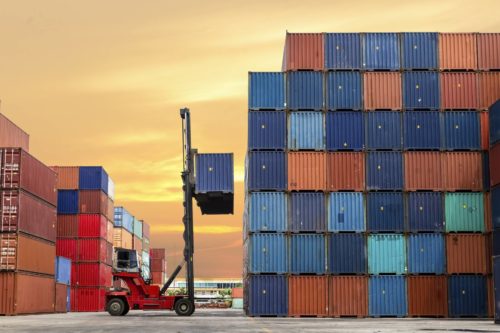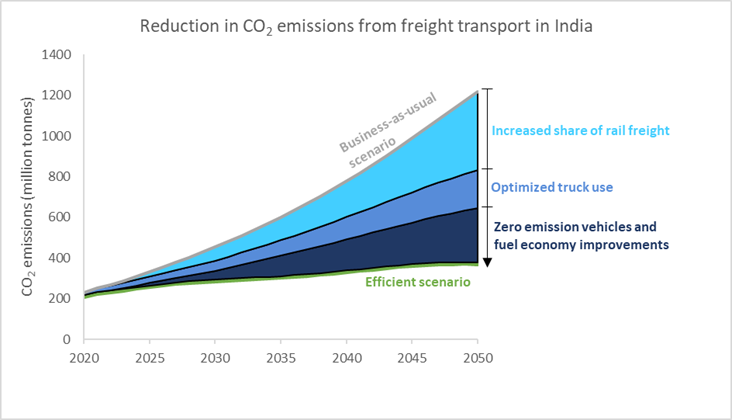
Opportunities for Cleaner, More Efficient Freight Transport in India
India will witness a rapid growth in freight transport over the coming decades. The country can implement a set of solutions to meet that growing demand cost-effectively and sustainably
This article was coauthored by Akshima Ghate of RMI India.
India is one of the fastest-growing economies in the world. Driven by the rising demand for goods and services in India, demand for freight transport is expected to grow fivefold over the next three decades. While the rising freight transport activity will be critical for country’s economic growth and competitiveness, it will also exacerbate challenges related to high logistics costs and high emissions. Logistics costs currently account for 14 percent of India’s gross domestic product (GDP), and the sector accounts for 42 percent of the nation’s overall CO2 emissions from transport. The root causes of these inefficiencies are a heavy reliance on roads to move freight, low operational and vehicle efficiency, and a lack of penetration of cleaner technology alternatives.
The recent Fast Tracking Freight report, coauthored by NITI Aayog and RMI, outlines opportunities for India to reduce the logistics costs to 10 percent of GDP, save 10 gigatons of CO2 emissions between 2020 and 2050, and reduce particulate matter and nitrogen oxide (NOx) emissions by 28 percent and 35 percent respectively over the same time frame.
As shown in the graph below, the report identifies three main opportunities:
- Increase the share of rail transport
- Optimize truck use
- Promote fuel-efficient and zero-emissions vehicle technologies

Opportunity 1: Increase the Share of Rail Transport
Today’s freight system in India relies heavily on road transport: 71 percent of freight moves on roads, while only 19 percent is transported via rail. Rail, a less expensive and less polluting mode of transportation, can be used to move a higher share of freight over long distances through the following solutions:
- Increase the rail network capacity: Rail networks can be upgraded by increasing trains’ load-carrying capacity, increasing train length, and improving the traffic speed and fluidity. New, specialized heavy-haul corridors can be built to move heavy bulk freight on dense networks, while India can keep prioritizing the build-out of Dedicated Freight Corridors (DFCs), which are high-capacity rail networks exclusively for freight.
- Increase the share of intermodal transportation: Intermodal transportation refers to the movement of goods in containers via different modes of transport. Its biggest use case is the movement of non-bulk goods such as consumer goods, electronics, paper, and so on. Intermodal’s share of freight movement can be increased through a well-planned exercise of identifying and upgrading high-potential corridors while ensuring better integration across rail, road, and water modes of transport.
Opportunity 2: Optimize Truck Use
Trucks in India are not used as efficiently as they could be, due to obsolete infrastructure, older vehicles, and the fragmentation of truck ownership. India’s trucking fleets as a whole see low utilization, a high percentage of empty trips, and trucks that are often overloaded. The following solutions can optimize the role of trucks in the Indian freight system:
- Improving transportation practices: Goods transport involves a series of practices like packaging, load matching, vehicle selection, loading, and unloading. Improving these practices across the supply chain can enhance trucking efficiency. Efficient packaging design can help optimize warehouse and truck space. Load matching can reduce delivery times and empty running. Once the load is matched, it is important to select the right type of vehicle for the right use case to optimize the load factors. Finally, standardization and digitization of processes such as pallet matching, implementing data protocols for tracking, and so on, can improve loading and unloading.
- Improving warehousing practices: High-quality warehouses, optimized siting, and digitized processes are crucial for inventory management. These factors are interrelated: digitization can enhance the quality of warehouses and help choose better sites. Better siting, in turn, reduces vehicle miles traveled and transit times.
Opportunity 3: Promote Fuel-Efficient and Zero-Emissions Vehicle Technologies
Trucks constitute less than 5 percent of India’s total vehicle fleet but contribute over 34 percent of transport-related CO2 and 53 percent of particulate emissions. The disproportionate emissions result from excessive reliance on diesel fuel, poor fuel economy, a lack of fuel-saving technologies, and a shortage of opportunities to finance those technologies. Solutions to reduce the impact of freight vehicles include:
- Improving the fuel economy of internal combustion engine vehicles: Advancements such as engine and drivetrain improvements, vehicle lightweighting, low rolling resistance tires, and aerodynamic modifications can all improve the fuel economy of freight vehicles. The government can set aggressive fuel consumption and emissions standards to support the uptake of these solutions. Peer-learning industry platforms can be used to share experiences with these technologies to create more confidence among logistics providers and aggregators.
- Promoting the use of ZEVs: ZEVs such as battery electric vehicles (BEVs) and fuel cell electric vehicles (FCEVs) have no tailpipe emissions and offer lower operating costs when compared with internal combustion engine vehicles. Policies such as upfront purchase incentives, ZEV mandates, vehicle scrappage schemes, and zero-emissions vehicle zones can spur both the demand and supply of ZEVs. Additionally, multistakeholder pilot projects can support policy implementation.
Moving Freight Forward
Concrete efforts from the government and industry players in a phased manner can unlock the opportunities and provide a path to implement the measures discussed above. The first phase should tap into solutions that are already economically feasible, such as rail network upgrades, bans on overloaded trucks, and state-level policies for freight electrification. The second phase should scale those solutions and focus on public-private collaboration for policy and infrastructure interventions to standardize and enable interoperability between transport modes and assets.
By Phase 3, India can aim to move 40 percent of freight demand to rail transport, shift all new freight vehicles sold to electric vehicles, and have best-in-class logistics practices. Efficient, cost-effective, and clean freight movement can elevate India’s logistics and export competitiveness across the world. It can also bolster domestic manufacturing and economic development, improve air quality, and mitigate the rise of greenhouse gas emissions—helping lead the way to a clean, efficient, and prosperous future.